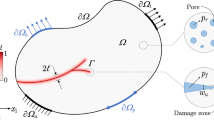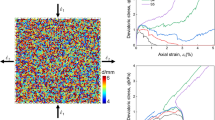Abstract
We present a simple unifying model that can be used to analyze, within a single framework, different dynamic regimes of shear deformation of brittle, plastic, and granular materials. The basic dynamic regimes seen in the response of both solids and granular materials to slowly increasing loading are scale-invariant behavior with power law statistics, quasi-periodicity of system size events, and persisting long term mode switching between the former two types of response. The model provides universal analytical mean field results on the statistics of failure events in the different regimes and distributed versus localized spatial responses. The results are summarized in a phase diagram spanned by three tuning parameters: dynamic strength change (weakening, neutral or strengthening) during slip events, dissipation of stress transfer (related to the void fraction in granular materials and damaged solids), and the ratio of shear rate over healing rate controlling the regaining of cohesion following failures in brittle solids. The mean field scaling predictions agree with experimental, numerical, and observational data on deformation avalanches of solids, granular materials, and earthquake faults. The model provides additional predictions that should be tested with future observation and simulation data.





Similar content being viewed by others
References
Aharonov, E., and D. Sparks (1999), Rigidity phase transition in granular packings, Phys. Rev E, 60, 6890-6896.
Aharonov, E., and D. Sparks (2002), “Shear profiles and localization in simulations of granular materials”, Phys. Rev. E 65, 051302/1-12.
Aharonov, E., and D. Sparks (2004), Stick-slip motion in simulated granular layers, J. Geophys. Res, 109, B09306.
Alava, M. J., P. K. V. V. Nukala, and S. Zapperi (2006), Statistical models of fracture, Advances in Physics, 55, 349–476.
Amit, R., E. Zilberman, N. Porat, and Y. Enzel (2002), Paleoseismic evidence for time-dependency of seismic response on a fault system - the southern Arava Valley, Red Sea Rift, Israel, Geol. Soc. Am. Bull., 114, 192–206.
Ashby, M. F., and C. G. Sammis (1990), The damage mechanics of brittle solids in compression, Pure Appl. Geophys., 133 (3), 489–521.
Baldassari A., et al. (2006), Brownian forces in sheared granular matter, Phys. Rev. Lett. 96, 118002.
Baud, P., E. Klein, and T.-F. Wong (2004), Compaction localization in porous sandstones: spatial evolution of damage and acoustic emission activity J. Struct. Geol., 26, 603-624.
Ben-David, O., S. M. Rubinstein and J. Fineberg (2010), Slip-stick and the evolution of frictional strength, Nature, 463, 76-79.
Ben-Zion, Y., and J. R. Rice (1993), Earthquake failure sequences along a cellular fault zone in a three-dimensional elastic solid containing asperity and nonasperity regions, J. Geophys. Res., 98, 14109-14131.
Ben-Zion, Y. (1996), Stress, slip and earthquakes in models of complex single-fault systems incorporating brittle and creep deformations, J. Geophys. Res., 101, 5677-5706.
Ben-Zion, Y., K. Dahmen, V. Lyakhovsky, D. Ertas, and A. Agnon (1999), Self-Driven Mode Switching of Earthquake Activity on a Fault System, Earth Planet. Sci. Lett., 172/1-2, 11-21.
Ben-Zion, Y., M. Eneva, and Y. Liu (2003), Large Earthquake Cycles and Intermittent Criticality On Heterogeneous Faults Due To Evolving Stress and Seismicity, J. Geophys. Res., 108, No. B6, 2307. doi:10.1029/2002JB002121.
Ben-Zion, Y., and V. Lyakhovsky (2006), Analysis of Aftershocks in a Lithospheric Model with Seismogenic Zone Governed by Damage Rheology, Geophys. J. Int., 165, 197-210. doi:10.1111/j.1365-246X.2006.02878.x.
Ben-Zion, Y. (2008), Collective behavior of earthquakes and faults: Continuum-discrete transitions, progressive evolutionary changes and different dynamic regimes, Rev. Geophys. 46, RG4006. doi:10.1029/2008RG000260.
Bruhn, R. L., W. T. Parry, W. A. Yonkee, and T. Thompson (1994), Fracturing and hydrothermal alteration in normal fault zones, Pure Appl. Geophys., 142, 609–645.
Bulatov, V. V., and A. S. Argon (1994), A stochastic model for continuum elasto-plastic behavior. I. Numerical approach and strain localization, Model. Simul. Mater. Sci. Eng. 2, 167.
Chen, K., P. Bak, and S. P. Obukhov (1991), “Self Organized Criticality in a crack-propagation model of earthquakes”, Phys. Rev. A 43, 625-630.
Chester, F. M., J. P. Evans, and R. L. Biegel (1993), Internal structure and weakening mechanisms of the San Andreas fault, J. Geophys. Res., 98, 771–786.
Chinnery, M. (1963), The stress changes that accompany strike-slip faulting, Bull. Seismol. Soc. Amer., 53, 921-932.
Csikor, F. F., C. Motz, D. Weygand, M. Zaiser, and S. Zapperi (2007), `Dislocation Avalanches, Strain Bursts, and the Problem of Plastic Forming at the Micrometer Scale’, Science 318, 251-254.
Dahmen, K., D. Ertas, and Y. Ben-Zion (1998), Gutenberg Richter and Characteristic Earthquake behavior in Simple Mean-Field Models of Heterogeneous Faults, Phys. Rev. E, 58, 1494-1501.
Dahmen, K., and Y. Ben-Zion (2009), The physics of jerky motion in slowly driven magnetic and earthquake fault systems, Encyclopedia of Complexity and System Science, R. Meyers (Eds.), Vol. 5, 5021-5037, Springer.
Dahmen, K. A., Y. Ben-Zion, and J. T. Uhl (2009), A micromechanical model for deformation in disordered solids with universal predictions for stress-strain curves and related avalanches, Phys. Rev. Lett., 102, 175501. doi:10.1103/PhysRevLett.102.175501.
Dahmen, K. A., Y. Ben-Zion, and J. T. Uhl (2011), A simple analytic theory for the statistics of avalanches in sheared granular materials, Nature Physics, 7, 554–557. doi:10.1038/NPHYS1957.
Daniels, K. E., and N. W. Hayman (2008), “Force chains in seismogenic faults visualized with photoelastic granular shear experiments” Journal of Geophysical Research, 113 B11411 and references therein.
Dieterich, J. H., and B. D. Kilgore (1996), Imaging surface contacts; power law contact distributions and contact stresses in quarts, calcite, glass, and acrylic plastic. Tectonophysics, 256, 219-239.
Dimiduk, D. M., C. Woodward, R. LeSar, and M. D. Uchic (2006), “Scale-Free Intermittent Flow in Crystal Plastity’’, Science 312, 1188-1190.
Falk, M. L., and J. S. Langer (1998), Dynamics of viscoplastic deformation in amorphous solids, Phys. Rev. E, 57(6), 7192–7205.
Fisher, D. S., K. Dahmen, S. Ramanathan, and Y. Ben-Zion (1997), Statistics of Earthquakes in Simple Models of Heterogeneous Faults, Phys. Rev. Lett., 78, 4885-4888.
Fisher, D. S. (1998), Collective transport in random media: from superconductors to earthquakes, Phys. Reports, 301, 113-150.
Hartley, R. R. (2004), Evolving force networks in deforming granular materials, PhD thesis, Duke University.
Hayman, N.W., L. Ducloue, K.L. Foco, K.E. Daniels (2011), Granular controls on periodicity of stick-slip events: kinematics and force-chains in an experimental fault, Pure and Applied Physics, in press.
Hickman, S. H., and B. Evans (1992), Growth of grain contacts in halite by solution transfer; Implications for diagenesis, lithification, and strength recovery, in Fault Mechanics and Transport Properties of Rocks, edited by B. Evans and T.-F. Wong, pp. 253–280, Academic, San Diego, Calif.
Jaeger, M., S. R. Nagel, and R. P. Behringer (1996), Granular solids, liquids, and gases, Rev. Mod. Phys., 68, 1259-1273.
Johnson, P. A., and X. Jia (2005), Nonlinear dynamics, granular media and dynamic earthquake triggering, Nature, 473, 871-874.
Kachanov, L. M. (1986), Introduction to continuum damage mechanics, pp. 135, Martinus Nijhoff Publishers.
Kuntz, M. and J.P.Sethna (2000), Noise in disordered systems: the power spectrum and dynamic exponents in avalanche models, Phys. Rev. B 62, 11699-11708.
Laurson, L., and M. J. Alava (2006), 1/f noise and avalanche scaling in plastic deformation, Phys. Rev. E 74, 066106.
Liu, A. J., and S. R. Nagel (eds) (2001), Jamming and Rheology, Taylor and Francis, New York.
Lyakhovsky, V., Y. Ben-Zion, and A. Agnon (2001), Earthquake Cycle, Fault Zones, and Seismicity Patterns in a Rheologically Layered Lithosphere, J. Geophys. Res., 106, 4103-4120.
Lyakhovsky, V. and Y. Ben-Zion (2008), Scaling relations of earthquakes and aseismic deformation in a damage rheology model, Geophys. J. Int., 172, 651-662. doi:10.1111/j.1365-246X.2007.03652.x.
Lyakhovsky, V. and Y. Ben-Zion (2009), Evolving geometrical and material properties of fault zones in a damage rheology model, Geochem. Geophys. Geosyst., 10, Q11011. doi:10.1029/2009GC002543.
Maloney, C. E. and M. O. Robbins (2009), Anisotropic Power Law Strain Correlations in Sheared Amorphous 2D Solids, Phys. Rev. Lett. 102, 225502.
Marco, S., M. Stein, A. Agnon, and H. Ron (1996), Long term earthquake clustering: a 50,000 year paleoseismic record in the Dead sea graben, J. Geophys. Res., 101, 6179-6192.
Marone, C. (1998), Laboratory-derived friction laws and their application to seismic faulting, Annu. Rev. Earth Planet. Sci., 26, 643-649.
Mehta, A. P., K. A. Dahmen, and Y. Ben-Zion (2006), Universal mean moment rate profiles of earthquake ruptures, Phys. Rev. E., 73, 056104.
Papanikolaou, S., F. Bohn, R. L. Sommer, G. Durin, S. Zapperi, and J. P. Sethna (2009), Beyond scaling: the average avalanche shape, arXiv:0911.2291.
Peng, Z., and Y. Ben-Zion (2006), Temporal changes of shallow seismic velocity around the Karadere-Duzce branch of the north Anatolian fault and strong ground motion, Pure Appl. Geophys., 163, 567-600. doi:10.1007/s00024-005-0034-6.
Petri, A., A. Baldassarri, F. Dalton, G. Pontuale, L. Pietronero, S. Zapperi, (2008) Stochastic dynamics of a sheared granular medium, EPJ B 64, 531.
Rechenmacher, A., Abedi, S. and Chupin, O. (2010), Evolution of Force Chains in Shear Bands in Sand, Geotechnique, 60, 343-351.
Richeton, T., J. Weiss, and F. Louchet (2005), Breakdown of avalanche critical behavior in polycrystalline plasticity, Nature Materials 4, 465-469.
Sethna, J.P., K. A. Dahmen, and C. R. Myers (2001), “Crackling Noise”, Nature, 410, 242-250.
Spaepen, F. (1977), A microscopic mechanism for steady state inhomogeneous flow in metallic glasses,Acta Metallurgica 25, 407-415.
Tsekenis, G. and K. A. Dahmen (2010) Depinning without a Jamming Point in Dislocation Systems, Phys. Rev. Lett., submitted.
Turcotte, D. L. (1997), Fractals and Chaos in Geology and Geophysics, Cambridge University Press.
Utsu, T., Y. Ogata, and R. S. Matsu’ura (1995), The centenary of the Omori Formula for a decay law of aftershock activity, J. Phys. Earth, 43, 1-33.
Weertman, J. (1996), Dislocation Based Fracture Mechanics, World Scientific.
Wong, T.-F., P. Baud and E. Klein (2001), Localized failure modes in a compactant porous rock. Geophys. Res. Lett. 28, 2521-2524.
Wu, C., Z. Peng, and Y. Ben-Zion (2009), Non-linearity and temporal changes of fault zone site response associated with strong ground motion, Geophys. J. Int., 176, 265–278. doi:10.1111/j.1365-246X.2008.04005.x.
Yu, P., T. Shannon, B. Utter, R.P. Behringer (2009), Stick-Slip in a 2D Granular Medium”, submitted.
Zaiser, M. (2006), Scale invariance in plastic flow of crystalline solids, Advances in Physics 55, 185-245.
Miguel M.C. and Zapperi, S. (2006), Fluctuations in plasticity at the microscale, Science 312, 1151-1152 and references therein.
Zhang, J., T.S. Majumdar, A. Tordesillas, and R.P. Behringer (2010), Statistical Properties of a 2D Granular Material Subjected to Cyclic Shear, Granular Matter, 12, 159–172.
Acknowledgments
YBZ acknowledges support from the National Science Foundation (grant EAR-0908903) and the US-Israel Binational Science Foundation (grant number 2008248). KD acknowledges support from NSF DMR 03-25939 (MCC) and thanks the USC Dept. of Earth Sciences and the Kavli Institute of Theoretical Physics at UC Santa Barbara for kind hospitality and support. The manuscript benefited from useful comments by Jay Finberg, Bob Behringer, and Charlie Sammis.
Author information
Authors and Affiliations
Corresponding author
Rights and permissions
About this article
Cite this article
Ben-Zion, Y., Dahmen, K.A. & Uhl, J.T. A Unifying Phase Diagram for the Dynamics of Sheared Solids and Granular Materials. Pure Appl. Geophys. 168, 2221–2237 (2011). https://doi.org/10.1007/s00024-011-0273-7
Received:
Revised:
Accepted:
Published:
Issue Date:
DOI: https://doi.org/10.1007/s00024-011-0273-7




